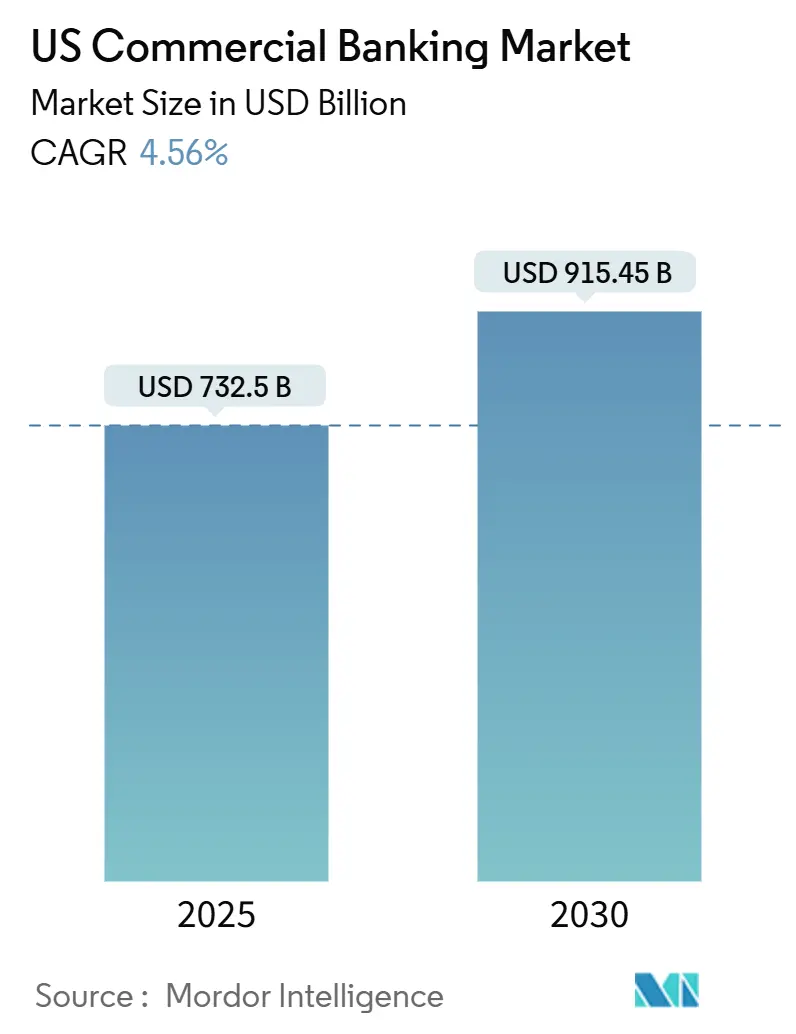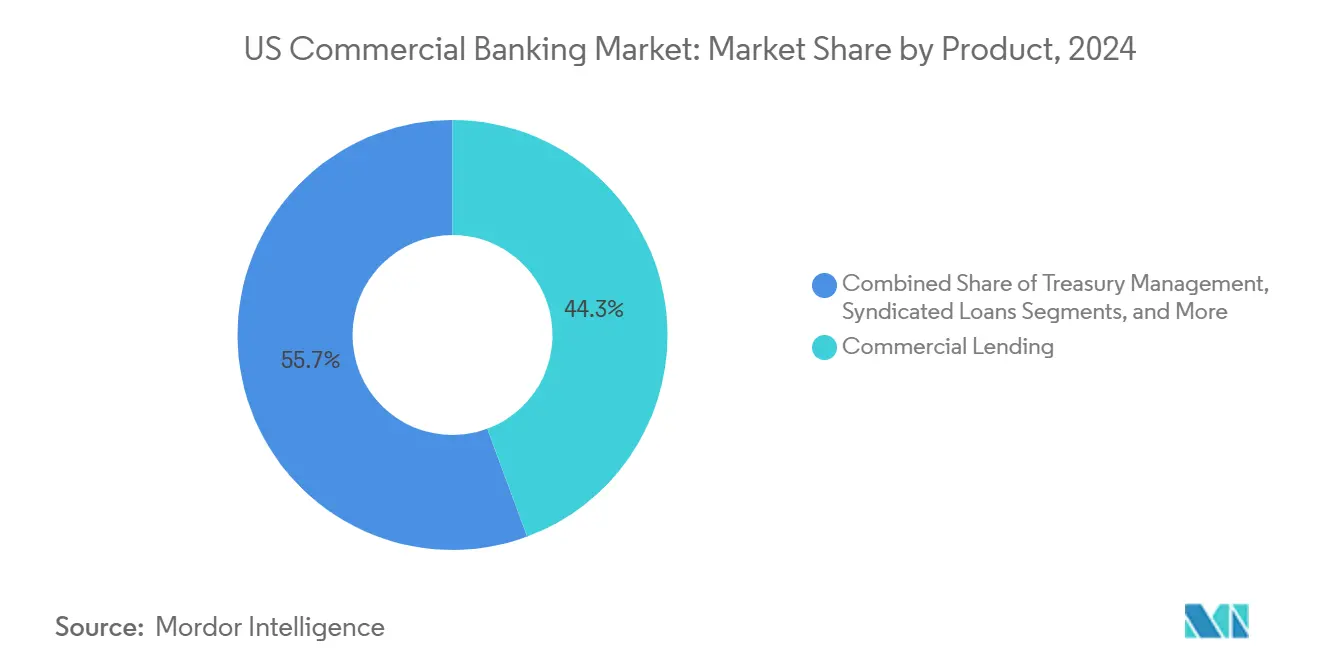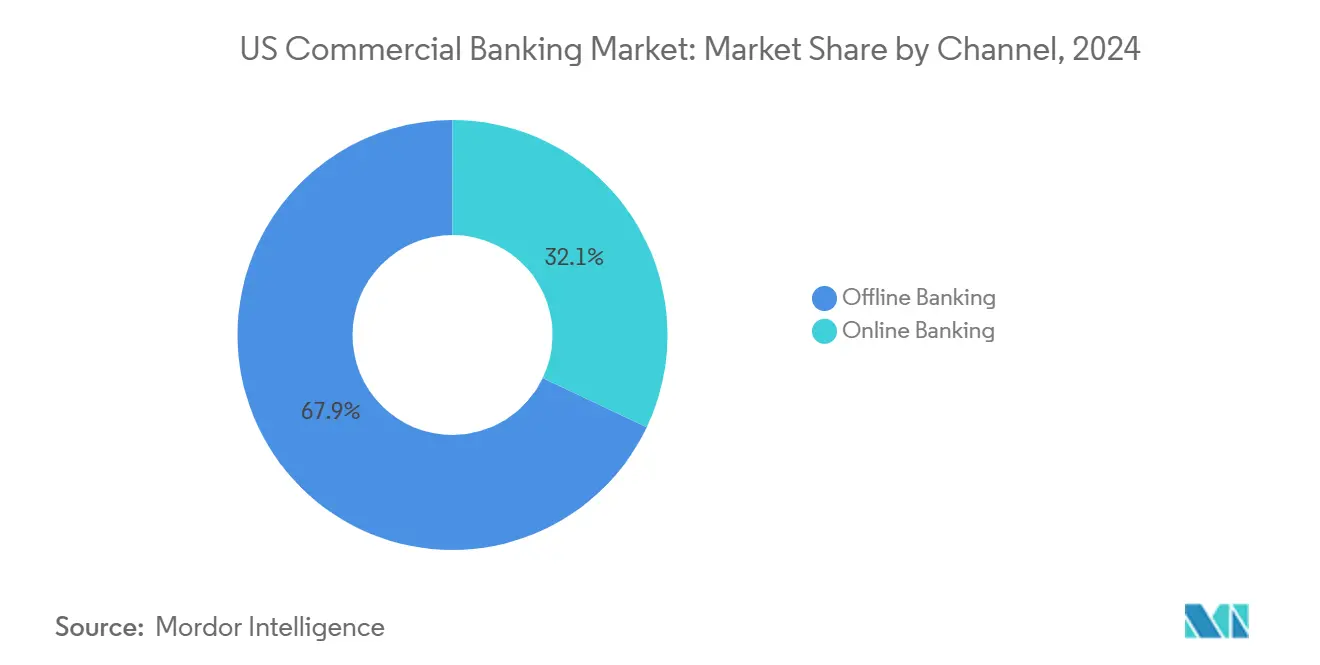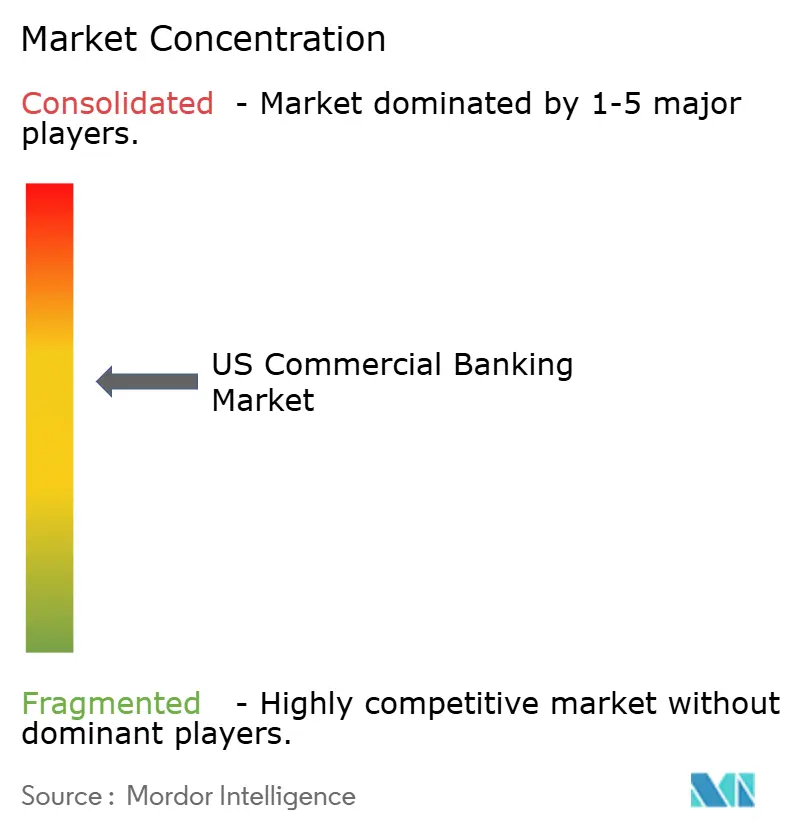US Commercial Banking Market Size and Share

US Commercial Banking Market Analysis by Mordor Intelligence
The US commercial banking market stands at USD 732.5 billion in 2025 and is forecasted to reach USD 915.45 billion by 2030, reflecting a 4.56% CAGR throughout the period. Resilient GDP growth, expanding real-time payments infrastructure, and steady capital ratios under Federal Reserve stress-test assumptions collectively reinforce confidence in the sector’s expansion. Banks are capturing structured-finance demand arising from on-shoring and federal infrastructure outlays, while fee-based products such as corporate treasury services are gaining momentum as net-interest margins stabilize near mid-cycle levels. Basel III “endgame” rules are nudging large institutions toward higher capital buffers, but disciplined cost management and broadening digital capabilities are preserving profitability. At the same time, embedded-finance platforms embedded in enterprise-resource-planning (ERP) systems pose disintermediation risks that require banks to accelerate open-API strategies and deepen advisory services.
Key Report Takeaways
- By product, commercial lending led with 44.34% of US commercial banking market share in 2024, whereas treasury management is projected to expand at a 6.79% CAGR through 2030.
- By client size, large enterprises accounted for 62.51% share of the US commercial banking market size in 2024, while Small and Medium Enterprises are forecasted to grow at 7.23% CAGR over 2025-2030.
- By channel, offline banking held 67.94% of the US commercial banking market in 2024; online banking is projected to be the fastest-growing channel at a 9.27% CAGR to 2030.
- By end-user industry, other industry verticals held 22.89% of the US commercial banking market in 2024, while healthcare and pharmaceuticals captured 6.55% CAGR to 2030.
US Commercial Banking Market Trends and Insights
Drivers Impact Analysis
| Driver | (~) % Impact on CAGR Forecast | Geographic Relevance | Impact Timeline |
|---|---|---|---|
| Robust US GDP and labor-market momentum | +1.2% | National; major metropolitan areas | Medium term (2–4 years) |
| Accelerating adoption of real-time payments & APIs | +0.8% | National; tech-forward regions | Short term (≤2 years) |
| Federal infrastructure-spending-led loan demand | +0.9% | National; Midwest and South | Long term (≥4 years) |
| Federal cannabis-banking reform unlocking new fee pools | +0.3% | State-level; legalized markets | Medium term (2–4 years) |
| On-shoring-driven middle-market capex financing | +0.7% | Manufacturing belt; Southwest | Long term (≥4 years) |
| Tax-credit monetization under the IRA | +0.4% | Renewable-energy corridors | Long term (≥4 years) |
| Source: Mordor Intelligence | |||
Robust US GDP and Labor-Market Momentum
US GDP is set to grow 2.7% in 2025, buoyed by productivity gains and sturdy consumer spending that lift business revenues and, in turn, credit demand[1]Capital Group, “US Economic Outlook 2025,” capitalgroup.com. Banks benefit as tighter labor markets elevate household earnings and enhance corporate cash flows, enabling stronger debt-service coverage ratios. A policy stance that holds the federal-funds rate near 4% sustains net-interest margins without compromising lending appetite. Portfolio credit costs remain in check, as unemployment hovers around multidecade lows. Productivity improvements registered since 2023 position corporate borrowers to fund expansion out of cash flow, lowering balance-sheet risk for lenders. Together, these elements create a favorable backdrop for the US commercial banking market through mid-decade.
Accelerating Adoption of Real-Time Payments & APIs
FedNow participation vaulted from 400 to more than 1,000 institutions between early 2024 and 2025. ISO 20022 messaging now underpins instant settlement, automated reconciliation, and rich data transfer that corporate treasurers demand. Banks embedding APIs into corporate ERP suites see rising fee income per account from programmable treasury services such as automated sweeps and dynamic cash forecasting. Community banks leverage third-party API partners to match the capabilities of larger rivals, extending the US commercial banking market relevance into rural economies. As real-time payments become table stakes, institutions that master interoperability and data analytics gain a durable share of operating deposits. The shift also yields operating-expense savings via straight-through processing, enhancing cost-income ratios.
Federal Infrastructure-Spending-Led Loan Demand
The USD 1.2 trillion Bipartisan Infrastructure Law is channeling the largest wave of state and local capital investment since 1979[2]U.S. Department of the Treasury, “Investing in America: State-Level Infrastructure Funding,” home.treasury.gov. Regional banks with entrenched local relationships are arranging construction lines, equipment leases, and working-capital facilities to contractors executing federally backed projects. Lower-income states in the South and Midwest receive outsized per-capita allocations, translating into predictable, multiyear lending pipelines. Ancillary service revenue emerges from payment guarantees, escrow management, and supply-chain financing tied to public-private partnerships. Because project timelines often exceed five years, bankers are locking in long-dated fee streams that cushion cyclical swings in traditional lending. The dispersed nature of projects also strengthens deposit franchises in communities previously underbanked by large nationals, broadening the footprint of the US commercial banking market.
Federal Cannabis-Banking Reform Unlocking New Fee Pools
Rescheduling cannabis to Schedule III will remove Section 280E tax penalties and lift margins for state-licensed operators, improving creditworthiness and attracting bank participation. Only 11% of community banks currently serve the sector, so first movers can secure sticky deposits and premium transaction fees once legislative clarity arrives. Compliance programs tailored to diverse state rules become competitive differentiators, allowing institutions to price higher account-analysis fees. Banks also foresee demand for armored-cash logistics, payroll services, and equipment loans geared toward cultivation facilities. Although initial volumes are modest relative to total assets, the incremental growth strengthens non-interest income, expanding the US commercial banking market in niche communities.
Restraints Impact Analysis
| Restraint | (~) % Impact on CAGR Forecast | Geographic Relevance | Impact Timeline |
|---|---|---|---|
| Escalating cybersecurity & fraud costs | −0.6% | National; major financial centers | Short term (≤2 years) |
| Basel III “end-game” capital tightening | −0.8% | National; $100 billion+ banks | Medium term (2–4 years) |
| Fed climate-stress-test capital limits | −0.3% | Regions exposed to climate risk | Long term (≥4 years) |
| Embedded-finance disintermediation via ERP ecosystems | −0.4% | Tech-forward markets | Medium term (2–4 years) |
| Source: Mordor Intelligence | |||
Escalating Cybersecurity & Fraud Costs
Bank IT budgets hit USD 107.8 billion in 2024, with a rising share directed at threat detection, zero-trust architectures, and real-time fraud interdiction. Treasury analysis warns that generative-AI tools empower fraudsters to craft adaptive malware, forcing banks to adopt similarly advanced analytics. Smaller institutions lack the scale to amortize escalating security spend, increasing merger pressure, or pushing them into managed-service arrangements. Elevated costs squeeze efficiency ratios, particularly when combined with declining overdraft and interchange income. Customer experience also suffers if multifactor authentication adds friction, giving fintechs an opening to capture transactional relationships. The drag on earnings, though moderate, subtracts from the US commercial banking market growth trajectory.
Basel III “End-game” Capital Tightening
The Federal Reserve’s July 2025 rules compel global systemically important banks to lift risk-weighted capital by 9%[3]Katten, “Basel Endgame Rulemaking Overview,” katten.com. Regional banks over USD 100 billion face standardized-model overlays that inflate credit-risk weights versus internal calculations, curbing balance-sheet capacity. Institutions respond by repricing term loans and revolving commitments higher to cover capital costs, which tempers credit demand. Some portfolios, such as leveraged loans or project finance, become uneconomical relative to return-on-equity thresholds. Capital planning dominates board agendas, nudging banks to divest non-core assets and accelerate wealth-management cross-selling that carries lower risk weights. While the sector remains well capitalized, the incremental headwind trims the upper bound of the US commercial banking market compared with a neutral-regulation scenario.
Segment Analysis
By Product: Treasury Management Accelerates Fee Diversification
Commercial lending retained the largest 44.34% slice of the US commercial banking market activity in 2024, yet it provides slower growth as capital rules tighten. Nevertheless, robust capex tied to on-shoring and infrastructure projects sustains baseline volumes. Syndicated credits and capital-markets distribution diversify risk and free capital for incremental growth. Trade-finance, supply-chain, and foreign-exchange products, grouped under Other Products, draw strength from complex cross-border commerce. The combined product mosaic underscores banks’ strategy to balance capital-intensive lending with scalable fee services, ensuring the US commercial banking market remains profitable across rate environments.
The treasury management segment is projected to rise 6.79% CAGR to 2030, outpacing every other line as corporates migrate from paper-based processes to real-time liquidity tools. The segment’s share of the US commercial banking market size is projected to climb considerably by 2030, reflecting a decisive pivot toward non-interest income. Middle-market firms deploy API-enabled dashboards that consolidate multi-bank positions, prompting banks to add predictive cash-flow models, automated investment sweeps, and foreign-exchange hedging within single portals. Treasury fees thus become stickier than spread-dependent loan revenue, reducing earnings volatility. Community banks with assets above USD 3 billion are entering the field using white-label fintech platforms that collapse implementation costs, enlarging the addressable client base for the US commercial banking market.

Note: Segment shares of all individual segments available upon report purchase
By Client Size: SME Digital Momentum Builds
Large enterprises commanded 62.51% of the US commercial banking market share in 2024, leveraging wide credit facilities, multicurrency treasury centers, and global cash pooling. Their sheer volume stabilizes the US commercial banking market during economic shifts and supplies predictable cross-sell revenue across custody, FX, and derivatives. Yet these clients increasingly self-fund routine working capital and tap capital markets directly, pressuring banks to focus on bespoke advisory and structured solutions that embed added value.
Small and medium enterprises are set to expand at a 7.23% CAGR through 2030, rapidly adopting digital onboarding, AI-driven underwriting, and low-touch working-capital lines. Cost-efficient technology allows banks to adjudicate credit in minutes, winning share from alternative lenders that once served the segment. Improved digital satisfaction has 95% of interactions occurring through mobile or web, although complex matters still trigger in-person consultations, reinforcing the hybrid ethos of the US commercial banking market. Banks that master scalable SME underwriting not only unlock growth but also diversify loan books traditionally concentrated in large corporate exposures.
By Channel: Hybrid Model Redefines Service Delivery
Offline Banking held 67.94% of the US commercial banking market share in 2024, demonstrating that face-to-face engagement remains essential for sophisticated credit, cash-management, and wealth-advisory mandates. Major banks such as Bank of America plan to open more than 150 branches by 2027, validating the physical-presence thesis. These outlets increasingly function as advisory lounges rather than teller windows, aligning cost-to-serve with relationship value.
Online Banking is expected to grow at a 9.27% CAGR over the forecast period, propelled by real-time payments and workflow integration that appeals to time-constrained treasurers. Omnichannel platforms route clients seamlessly between chat, video, and branch appointments while persisting data to avoid rekeying. As the US commercial banking market size for online channels expands, institutions integrate analytics to nudge clients toward revenue-generating products at contextual moments. A growing number of banks now route 62% of all real-time payment transactions through online or mobile applications, illustrating digital uptake even among legacy depositors. The emerging equilibrium is not channel substitution but synchronized delivery, curating convenience without sacrificing high-touch counsel.

By End-User Industry Vertical: Healthcare Spurs Specialized Finance
The Other Industry Verticals segment held 22.89% of the US commercial banking market share in 2024. Healthcare and pharmaceuticals records the fastest 6.55% CAGR, thanks to demographic aging, electronic-health-record mandates, and capital-intensive equipment upgrades. Banks cultivate sectoral expertise in revenue-cycle lending, practice-acquisition finance, and supply-chain management, capturing premium yields. The vertical’s compliance burden raises switching costs, locking in long-term relationships that bolster the US commercial banking market.
Manufacturing is resurgent amid on-shoring subsidies, demanding machinery leases, and factory retrofits aligned to automation. Retail and E-commerce show mixed fortunes: big-box footprints shrink even as online merchants require fulfillment-center loans and inventory lines. Information Technology and Telecommunications borrowers seek venture debt tied to artificial-intelligence rollouts, while the Public Sector preserves a stable but slower-growing base centered on municipal-bond underwriting. Each vertical adds diversification, letting banks hedge sector shocks while reinforcing consultative credibility.
Geography Analysis
The Northeast and West Coast collectively account for nearly half of outstanding commercial loans, reflecting dense corporate clusters, advanced technology ecosystems, and higher average ticket sizes. New York, Massachusetts, and California anchor complex treasury-management and capital-markets engagements that drive fee income. Yet the South and Southwest are the fastest-growing regions, with combined loan balances expanding at more than 6% annually as population inflows fuel small-business formation and residential construction. The US commercial banking market in Texas has experienced significant growth in 2024 and is expected to surpass national growth rates through 2030.
Infrastructure spending reshapes the Midwest, where federally backed road and bridge upgrades catalyze equipment financing for contractors and materials suppliers. Lower-income Mississippi and Alabama receive high per-capita allocations, enabling regional banks to underwrite multiyear projects with limited credit loss expectations. Cannabis legalization creates first-mover fee opportunities for banks in Illinois, Michigan, and Ohio, while institutions in prohibition states monitor regulatory signals before investing in compliance systems.
Climate-related physical risks vary across geographies. Southeastern institutions confront hurricane exposure that influences credit modeling and capital allocations under the Federal Reserve’s climate stress scenarios. Pacific Coast banks manage wildfire risk and water-scarcity covenants in real-estate loans. Geographic diversification thus becomes a strategic imperative, prompting nationwide lenders to hedge exposures and regional banks to deploy sectoral expertise within their home markets. Collectively, these dynamics sustain a balanced, regionally nuanced US commercial banking market.
Competitive Landscape
The US commercial banking market is moderately concentrated and rapidly reshaping. Competitive intensity is escalating as traditional institutions confront technology, regulation, and consolidation all at once. Capital One’s USD 35.3 billion purchase of Discover, finalized in May 2025, created the eighth-largest US bank and positioned the merged entity as the top credit-card issuer. This transaction signals a renewed M&A cycle, enabled by regulators that now weigh systemic stability against the need for competition. Banks with sub-USD 100 billion assets are evaluating strategic alternatives to meet rising compliance costs, spurring a pipeline of transactions across the Midwest and Southeast.
Technology adoption has become the decisive battleground. Large banks deploy generative-AI models to automate software coding, detect fraud in real time, and generate client insights that augment advisory services. Productivity gains reach 20% in certain operations, freeing capacity for revenue-generating tasks. Meanwhile, ERP-embedded finance providers siphon routine payment flows, compelling banks to open APIs and reposition products as invisible services within corporate workflows. Early movers secure proprietary data insights that reinforce pricing power, illustrating the virtuous cycle now reshaping the US commercial banking market.
Capital regulation tilts advantages toward scale players that can diversify risk across product silos and geographies. Nevertheless, niche specialists thrive by focusing on healthcare banking, renewable-energy project finance, or community-centric relationship models. Regional banks exploit local intelligence to compete on service responsiveness, even as they outsource core processing to cloud vendors to achieve cost parity. Taken together, the competitive mosaic underscores a moderately concentrated yet dynamically shifting US commercial banking market.
US Commercial Banking Industry Leaders
JPMorgan Chase & Co.
Bank of America Corp.
Wells Fargo & Co.
Citigroup Inc.
U.S. Bancorp
- *Disclaimer: Major Players sorted in no particular order

Recent Industry Developments
- May 2025: Capital One closed its USD 35.3 billion acquisition of Discover Financial Services, creating the eighth-largest US bank by assets.
- April 2025: Columbia Banking System announced a USD 2 billion all-stock purchase of Pacific Premier Bancorp.
- April 2025: The Federal Reserve and OCC approved Capital One’s Discover deal after a detailed review.
- March 2025: First Busey Corporation finalized its acquisition of CrossFirst Bankshares, taking combined assets to roughly USD 20 billion.
Research Methodology Framework and Report Scope
Market Definitions and Key Coverage
Our study defines the United States commercial banking market as all fee and interest income earned when licensed U.S.-chartered commercial banks serve business customers through commercial lending, syndicated loans, capital-market facilitation, treasury and cash-management services delivered across physical branches, relationship desks, and online portals. Values are expressed in nominal U.S. dollars and represent on-shore activity booked on a consolidated basis.
Scope Exclusions: Proprietary trading desks, pure investment-bank advisory, and retail-only deposit activity sit outside this frame.
Segmentation Overview
- By Product
- Commercial Lending
- Treasury Management
- Syndicated Loans
- Capital Markets
- Other Products
- By Client Size
- Large Enterprises
- Small & Medium Enterprises (SME)
- By Channel
- Online Banking
- Offline Banking
- By End-User Industry Vertical
- IT & Telecommunication
- Manufacturing
- Retail And E-Commerce
- Public Sector
- Healthcare And Pharmaceuticals
- Other Industry Verticals
Detailed Research Methodology and Data Validation
Primary Research
Mordor analysts interview commercial credit officers, treasury managers, and fintech platform partners across the Northeast, Midwest, Sunbelt, and Pacific regions. These discussions clarify lending appetite shifts, fee renegotiation practices, and digital-channel uptake, letting us verify desk findings and close data gaps before bottom-up adjustments.
Desk Research
We start with foundational statistics from the Federal Deposit Insurance Corporation, the Federal Reserve H.8 series, and the Office of the Comptroller of the Currency, which anchor asset, deposit, and loan pools. Trade associations such as the American Bankers Association, the Clearing House, and the Independent Community Bankers of America provide product-level penetration and cost benchmarks. Annual reports, 10-Ks, and investor decks from leading national and regional banks help our team cross-check margin movements and fee mixes. Paid archives, notably D&B Hoovers for company financials and Dow Jones Factiva for transaction news, round out the desk review. This list is illustrative, not exhaustive, as many other public and proprietary sources inform data collection and validation.
Market-Sizing & Forecasting
A top-down reconstruction built from Federal Reserve balance-sheet aggregates and FDIC income tables is combined once with selective bottom-up bank-cluster roll-ups to test totals. Key variables like net interest margin trends, C&I loan growth, treasury-service adoption rates, fintech partnership penetration, and Basel III end-game capital buffers shape the model. Multivariate regression weighs each driver and projects values through 2030, while scenario analysis tests rate and GDP shocks. Any bottom-up variance beyond +/-5% is revisited with field contacts.
Data Validation & Update Cycle
Outputs pass a two-step peer review, then an analyst reruns anomaly checks against new regulatory filings; material events trigger interim revisions. Reports refresh annually so clients receive an up-to-date view.
Why Our US Commercial Banking Industry Size & Share Analysis Baseline Deserves Trust
Published estimates often diverge because firms pick different revenue lines, customer cohorts, and refresh cadences.
External figures range from roughly USD 1.5 trillion for a broad NAICS 52211 asset view to about USD 232 billion for an SME-centric slice, while another source blending fee and interest streams suggests USD 950 billion. Mordor places 2025 market value at USD 732.5 billion, reflecting only in-scope commercial revenue lines.
Benchmark comparison
| Market Size | Anonymized source | Primary gap driver |
|---|---|---|
| USD 732.5 B (2025) | Mordor Intelligence | - |
| USD 1.5 T (2024) | Regional Consultancy A | Includes total bank assets and interest revenue, no product filter, currency conversions unadjusted |
| USD 0.95 T (2024) | Global Consultancy B | Mixes net interest and fee income yet double-counts inter-bank transfers |
| USD 232 B (2024) | Trade Journal C | Focuses on SME segment and omits large-enterprise and capital-market fees |
In sum, our disciplined scope selection, dual-approach modeling, and yearly refresh cadence give decision-makers a balanced, transparent baseline that is traceable to clear variables and repeatable steps.
Key Questions Answered in the Report
What is the current size of the US commercial banking market?
The US commercial banking market size is USD 732.5 billion in 2025 and is on track to hit USD 915.45 billion by 2030.
Which product area is growing fastest?
Treasury Management services lead growth at a 6.79% CAGR through 2030 as businesses adopt real-time liquidity and API-driven cash-management tools.
How will Basel III endgame rules affect commercial lending?
Required capital increases of 9% for large banks will raise pricing on risk-weighted assets and may constrain aggregate loan growth by roughly 0.8 percentage points across the forecast horizon.
Why is the healthcare sector attractive to banks?
Healthcare clients need specialized revenue-cycle financing, equipment loans, and regulatory-compliant treasury solutions, driving a 6.55% CAGR and higher fee yields compared with many other verticals.
Are physical branches still relevant in commercial banking?
Yes. Although online transactions are expanding at 9.27% CAGR, 67.94% of 2024 activity still flowed through branches, which remain vital for complex advisory and relationship management.
What opportunities could cannabis banking reform create?
Rescheduling cannabis at the federal level could unlock new deposit pools, transaction fees, and loan demand in states where the industry is legalized, adding roughly 0.3 percentage point to market CAGR once enacted.



